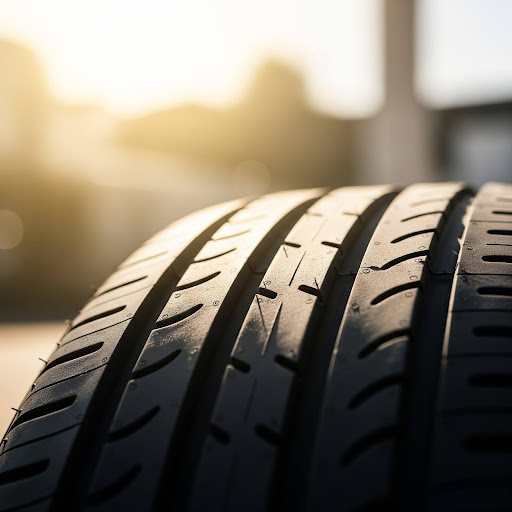Tire maintenance & safety
Free shipping
Best price guarantee
SimpleCrew exclusive savings
0% financing options
Tire replacement coverage
24/7 roadside assistance
Easy returns

As the mercury rises and summer temperatures soar, it's crucial to consider the impact of extreme heat on your vehicle's tires. Scorching pavement and sizzling asphalt can wreak havoc on your tires, compromising their performance, safety, and longevity.
Tires are the only point of contact between your vehicle and the road, making it essential to ensure they are well-equipped to handle the challenges posed by hot weather conditions. Neglecting your tires during the summer months can lead to increased wear, reduced traction, and even dangerous blowouts.
To help you navigate the complexities of tire care in extreme heat, we've compiled a comprehensive guide on choosing the right tires for hot weather and maintaining them throughout the summer season. By understanding the unique demands placed on your tires during this time of year, you can make informed decisions to keep your vehicle running smoothly and safely.
What are Extreme Heat Tires?
Extreme heat tires are specially designed to withstand the rigors of high-temperature driving conditions. These tires are engineered using advanced rubber compounds and innovative tread designs that prioritize heat resistance and durability.
The primary goal of extreme heat tires is to maintain optimal performance and safety even when exposed to scorching temperatures. They are built to resist heat-related wear, minimize the risk of blowouts, and provide reliable traction on hot road surfaces.
By investing in extreme heat tires, you can have peace of mind knowing that your vehicle is equipped to handle the demands of summer driving. These tires offer enhanced safety, improved performance, and extended tire life, making them an excellent choice for those who frequently encounter hot weather conditions.
How to Choose the Right Tires for Hot Weather
Selecting the right tires for hot weather demands a keen understanding of how heat affects tire performance and safety. High temperatures can lead to increased air pressure, accelerated tread wear, and reduced traction, all of which can compromise the safety and efficiency of your vehicle. The best approach involves a careful examination of tire composition, tread design, and maintenance practices that account for temperature fluctuations.
1. Look for Heat-Resistant Materials
High temperatures put stress on tires, making it vital to select those designed to endure extreme conditions. Opt for tires that utilize innovative materials specifically engineered to resist the degradation caused by heat. By choosing these advanced tire technologies, you enhance the safety of your vehicle and minimize the likelihood of tire-related issues.
Benefits of Advanced Tire Technologies
- Extended Tire Life: Tires incorporating cutting-edge materials tend to wear at a slower rate, offering a longer lifespan and reducing the frequency of replacements.
- Consistent Performance: These tires maintain their performance levels even in scorching conditions, ensuring reliable handling and control on heated roadways.
Beyond the rubber, advanced tire technologies often feature robust internal structures designed for stability in high temperatures. These innovations include elements such as specialized ply layers and enhanced sidewall designs, which collectively help the tire maintain its shape and resist the strains of intense heat.
2. Consider Tread Design for Hot Weather
The role of tread design extends beyond aesthetics; it is critical for managing the effects of heat on tires. Innovative tread patterns are essential for maximizing performance and ensuring safety during high-temperature conditions. These designs help maintain the tire's temperature and optimize its contact with the road, even as heat intensifies.
Key Elements of Heat-Resistant Tread Patterns
A tire's tread pattern can significantly influence its ability to perform under hot conditions. Look for tires with features that facilitate air circulation and reduce heat buildup. These elements ensure that the tire remains cool, providing stability and reducing the risk of heat-related issues.
- Cooling Grooves: Strategically placed grooves enhance airflow around the tire, helping to disperse heat more effectively.
- Optimized Traction Features: Advanced tread elements offer superior grip, critical for maintaining control on hot, slick roads.
The tread design also contributes to uniform tire wear, ensuring that the tire's contact patch remains optimal. This consistency is vital for maintaining control and safety, particularly when roads become exceedingly hot.
Selecting the Right Tread for Your Needs
Choosing a tread design that matches your driving conditions can significantly improve your vehicle's capability in hot weather. Tires with specific tread patterns, such as those designed for enhanced cornering and efficient water dispersal, are beneficial for handling the unique challenges posed by summer driving.
3. Monitor Tire Pressure Regularly
Keeping a close eye on tire pressure is essential, particularly during the summer months when temperatures can cause significant changes. As the heat intensifies, the air within tires expands, leading to variations that can affect performance and safety. Consistent monitoring not only helps maintain the recommended pressure but also extends the life of your tires.
Importance of Consistent Pressure Maintenance
Consistent tire pressure maintenance is vital for optimizing vehicle performance and ensuring safety on the road. Properly maintained tires contribute to a smoother driving experience and can prevent various issues associated with improper inflation.
- Enhanced Performance: Correctly inflated tires ensure that the vehicle uses energy efficiently, which can lead to better overall performance. This efficiency is crucial during summer, as it helps counteract the additional demands on the vehicle's systems.
- Improved Stability: Proper inflation levels help maintain the tire's shape, ensuring a consistent contact patch with the road. This stability is particularly important on hot surfaces, where traction can be compromised.
Effective Practices for Managing Tire Pressure
To ensure your tires remain in optimal condition, incorporate regular pressure checks into your vehicle maintenance routine. This proactive approach helps identify issues before they escalate.
- Measure During Cooler Periods: Check tire pressure when tires are cool to obtain accurate readings. This typically means measuring before driving or after the vehicle has been parked for a while.
- Consult Vehicle Specifications: Refer to the vehicle’s specifications for the correct tire pressure settings, usually found in the owner’s manual or on the driver’s side door jamb.
By prioritizing regular tire pressure checks, you can safeguard against the effects of heat, ensuring that your vehicle remains safe and efficient throughout the summer season. This vigilance helps prevent premature wear and supports the longevity of your tires.
4. Choose the Best Tires for Hot Climates

Navigating hot climates demands a careful selection of tires that can withstand high temperatures while maintaining performance and safety. Summer and all-season tires are particularly well-suited for these conditions, thanks to their specialized construction and design. These tires are formulated to handle extreme heat, ensuring consistent traction and durability on hot pavement.
Advantages of Summer Tires
Summer tires are specifically engineered to excel in warm weather. The rubber compounds used in these tires are designed to remain stable at higher temperatures, providing excellent grip and responsiveness. This stability is crucial for drivers who need to maintain control during sudden maneuvers or quick stops in the summer heat.
- Optimized Grip: The tread patterns of summer tires are tailored for enhanced road contact, improving handling and cornering abilities.
- Enhanced Structural Integrity: With reinforced sidewalls, these tires offer better resistance to heat-induced deformation, supporting consistent performance.
All-Season Tires: A Versatile Option
All-season tires offer a practical solution for those who encounter a variety of weather conditions but still require reliable performance in the heat. While not as specialized as summer tires, all-season options provide a balanced approach to handling both dry and wet surfaces.
- Versatile Performance: These tires accommodate a range of temperatures and conditions, making them a dependable choice for year-round use.
- Economic Efficiency: By meeting the requirements of multiple seasons, all-season tires can reduce the frequency of tire replacements, offering cost savings over time.
Understanding the demands of your driving environment is key to selecting the right tires for hot climates. Whether prioritizing the precision of summer tires or the adaptability of all-season options, ensuring high-quality materials and compatibility with your vehicle's specifications is essential for optimal performance and safety.
Tips on Maintaining Tires in Summer
Proper tire maintenance during summer ensures not only safety but also extends the life of your tires. As temperatures climb, small maintenance steps can prevent costly repairs and improve your driving experience. With a focus on vigilance and care, these tips will help you keep your tires in optimal condition.
1. Check Tire Pressure Frequently
Summer’s intense heat can affect tire pressure, making it crucial to stay alert to changes. Regularly using a reliable gauge to ensure tires are not over- or under-inflated helps maintain balance and performance. Accurate pressure supports better fuel efficiency and reduces the risk of blowouts on scorching roads.
- Frequent Assessments: Conduct pressure checks bi-weekly during peak summer months to ensure stability.
- Optimal Conditions: Aim to measure pressure in the early morning or late evening when temperatures are cooler.
2. Inspect Tires for Wear and Damage
Heat can exacerbate existing tire wear, making regular inspections crucial. Examine each tire for signs of tread wear, cracks, or bulges, which indicate potential problems. Spotting these issues early can prevent further damage and ensure your tires remain safe for summer driving.
- Visual and Manual Checks: Look for uneven tread patterns and run your hand over the tire surface to feel for irregularities.
- Professional Inspections: If unsure, seek a professional evaluation to assess any discovered damage accurately.
3. Park in Shade When Possible
Reducing direct sunlight exposure helps maintain tire integrity. Parking in shaded areas minimizes heat absorption and slows down the degradation of rubber compounds. This simple step can make a significant difference in maintaining tire quality over time.
- Strategic Parking: Choose parking spots under trees or structures to shield your vehicle from the sun.
- Use of Reflective Covers: Consider using tire covers for added protection when parking in direct sunlight is unavoidable.
4. Avoid Overloading
Excess weight strains your tires, especially in hot conditions where the risk of overheating increases. Adhere to your vehicle's load capacity, and distribute weight evenly to prevent unnecessary stress on any single tire. This practice not only protects your tires but also enhances fuel efficiency and vehicle handling.
- Check Vehicle Specs: Refer to the vehicle manual for maximum load guidelines to avoid exceeding limits.
- Balanced Load Distribution: Arrange cargo evenly in the vehicle to ensure even weight distribution across all tires.
By following these maintenance tips, you can ensure your tires remain in peak condition throughout the summer months. These proactive measures contribute to safer driving experiences and extend the life of your tires, keeping your journeys smooth and worry-free.
As you embark on your summer driving adventures, remember that the right tires and proper maintenance are essential for navigating the challenges of extreme heat. By choosing tires designed for hot weather and following our tips for summer tire care, you can ensure a safer, more efficient, and enjoyable driving experience. When you're ready to find the perfect tires for your vehicle, shop for tires online with us and discover the best deals to keep you rolling through the summer heat.
Ready to find the perfect tires?
Search By